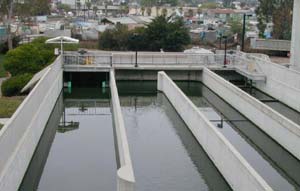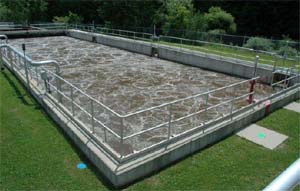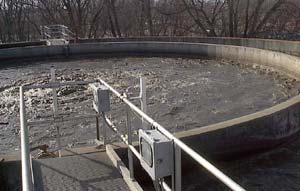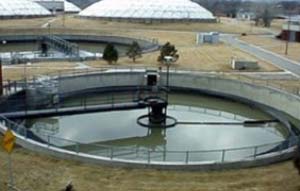|

 

Waste Water Treatment Plant
Sewage treatment is the process that removes the
majority of the contaminants from waste-water or sewage and produces
both a liquid effluent suitable for disposal to the natural environment
and a sludge. To be effective, sewage must be conveyed to a treatment
plant by appropriate pipes and infrastructure and the process itself
must be subject to regulation and controls. Other wastewaters require
often different and sometimes specialised treatment methods. At the
simplest level treatment of sewage and most wastewaters is through
separation of solids from liquids, usually by settlement. By
progressively converting dissolved material into solid , usually a
biological floc and settling this out, an effluent stream of increasing
purity is produced.
Description
Sewage is the liquid waste from toilets, baths,
showers, kitchens, etc. that is disposed of via sewers. In many areas
sewage also includes some liquid waste from industry and commerce. In
many countries, the waste from toilets is termed foul waste, the waste
from items such as basins, baths, kitchens is termed sullage water, and
the industrial and commercial waste is termed trade waste. The division
of household water drains into greywater and blackwater is becoming more
common in the developed world, with grey water being permitted to be
used for watering plants or recycled for flushing toilets. Much sewage
also includes some surface water from roofs or hard-standing areas.
Municipal wastewater therefore includes residential, commercial, and
industrial liquid waste discharges, and may include storm water runoff.
The site where the process is conducted is called a sewage treatment
plant. The flow scheme of a sewage treatment plant is generally the same
for all countries:
● Mechanical treatment
Influx (Influent)
Removal of large objects
Removal of sand
Pre-precipitation
● Biological treatment
Oxidation bed (oxidizing bed) or Aerated systems
Post precipitation
Effluent
● Chemical treatment
(this step is usually combined with settling and
other processes to remove solids, such as filtration. The combination is
referred as physical-chemical treatment. It is rarely used along with
biological treatment.).
Treatment stages
Primary treatment
Primary treatment is to reduce oils, grease, fats, sand, grit, and
coarse (settleable) solids. This step is done entirely with machinery,
hence the name mechanical treatment.
Influx (influent) and removal of large objects
In the mechanical treatment, the influx (influent) of sewage water is
strained to remove all large objects that are deposited in the sewer
system, such as rags, sticks, condoms, sanitary towels (sanitary
napkins) or tampons, cans, fruit, etc. This is most commonly done using
a manual or automated mechanically raked screen. This type of waste is
removed because it can damage the sensitive equipment in the sewage
treatment plant.
Sand and grit removal
This stage typically includes a sand or grit channel where the velocity
of the incoming wastewater is carefully controlled to allow sand grit
and stones to settle but still maintain the majority of the organic
material within the flow. This equipment is called a detritor or sand
catcher. Sand grit and stones need to be removed early in the process to
avoid damage to pumps and other equipment in the remaining treatment
stages. Sometimes there is a sand washer (grit classifier) followed by a
conveyor that transports the sand to a container for disposal. The
contents from the sand catcher may be fed into the incinerator in a
sludge processing plant but in many cases the sand and grit is sent to a
land-fill.
Sedimentation
In almost all plants there is a sedimentation stage where the sewage is
allowed to pass through large circular or rectangular tanks. The tanks
are large enough that faecal solids can settle and floating material
such as grease and plastics can rise to the surface and be skimmed off.
The main purpose of the primary stage is to produce a generally
homogeneous liquid capable of being treated biologically and a sludge
that can be separately treated or processed. Primary settlement tanks
are usually equipped with mechanically driven scrapers that continually
drive the collected sludge towards a hopper in the base of the tank from
where it can be pumped to further sludge treatment stages.
Secondary treatment
Secondary treatment is designed to substantially degrade the biological
content of the sewage such as are derived from human waste, food waste,
soaps and detergent. The majority of municipal and industrial plants
treat the settled sewage liquor using aerobic biological processes. For
this to be effective, the biota require both oxygen and a substrate on
which to live. There are number of ways in which this is done. In all
these methods, the bacteria and protozoa consume biodegradable soluble
organic contaminants (e.g. sugars, fats, organic short-chain carbon
molecules, etc.) and bind much of the less soluble fractions into floc
particles. Secondary treatment systems are classified as fixed film or
suspended growth. In fixed film systems - such as roughing filters - the
biomass grows on media and the sewage passes over its surface. In
suspended growth systems - such as activated sludge - the biomass is
well mixed with the sewage. Typically, fixed film systems require
smaller footprints than for an equivalent suspended growth system;
however, suspended growth systems are more able to cope with shocks in
biological loading and provide higher removal rates for BOD and
suspended solids than fixed film systems.
Activated sludge
Activated sludge plants use a variety of mechanisms and processes to use
dissolved oxygen to generate a biological floc that substantially
removes organic material. It also traps particulate material and can,
under ideal conditions, convert ammonia to nitrite and nitrate and
ultimately to nitrogen gas, (see also denitrification).
Filter Beds (Oxidising beds)
In older plants and plants receiving more variable loads, trickling
filter beds are used where the settled sewage liquor is spread onto the
surface of a deep bed made up of coke (carbonised coal), limestone chips
or specially fabricated plastic media. Such media must have high surface
areas to support the biofilms that form. The liquor is distributed
through perforated rotating arms radiating from a central pivot. The
distributed liquor trickles through this bed and is collected in drains
at the base. These drains also provide a source of air which percolates
up through the bed, keeping it aerobic. Biological films of bacteria,
protozoa and fungi form on the medias' surfaces and eat or otherwise
reduce the organic content.
Secondary sedimentation
The final step in the secondary treatment stage is to settle out the
biological floc or filter material and produce an effluent with very low
levels of organic material and suspended matter.
Tertiary treatment
Tertiary treatment provides a final stage to raise the effluent quality
to the standard required before it is discharged to the receiving
environment (sea, river, lake, ground, etc.) More than one tertiary
treatment process may be used at any treatment plant. If disinfection is
practiced, it is always the final process.
Effluent polishing
Filtration
Sand filtration removes much of the residual suspended matter.
Filtration over activated carbon removes residual toxins.
Nutrient removal
Wastewater may also contain high levels of nutrients (nitrogen and
phosphorus) that in certain forms may be toxic to fish and invertebrates
at very low concentrations (e.g. ammonia) or that can create nuisance
conditions in the receiving environment (e.g. weed or algal growth).
Weeds and algae may seem to be an aesthetic issue, but algae can produce
toxins, and their death and consumption by bacteria (decay) can deplete
oxygen in the water and suffocate desirable fish. Where receiving rivers
discharge to lakes or shallow seas, the added nutrients can cause severe
eutrophication losing many sensitive clean water fish. The removal of
nitrogen and/or phosphorus from wastewater can be achieved either
biologically or by chemical precipitation.
Nitrogen removal is effected through the biological reduction of
nitrogen from the ammonia to nitrate (nitrification), and then from
nitrate to nitrogen gas (denitrification), which is released to the
atmosphere. These conversions require carefully controlled conditions to
encourage the appropriate biological communities to form. Sand filters,
lagooning and reed beds can all be used to reduce nitrogen. Sometimes
the conversion of toxic ammonia to nitrate alone is referred to as
tertiary treatment.
Phosphorus removal can be effected biologically in a process called
enhanced biological phosphorus removal. In this process specific
bacteria, called Polyphosphate accumulating Organisms, are selectively
enriched and accumulate large quantities of phosphorus within their
cells. When the biomass enriched in these bacteria is separated from the
treated water, the bacterial biosolids have a high fertilizer value.
Phosphorus removal can also be achieved, usually by chemical
precipitation with salts of iron (e.g. ferric chloride) or aluminum
(e.g. alum). The resulting chemical sludge, however, is difficult to
dispose of, and the use of chemicals in the treatment process is
expensive and makes operation difficult and often messy.
Disinfection
The purpose of disinfection in the treatment of wastewater is to
substantially reduce the number of living organisms in the water to be
discharged back into the environment. The effectiveness of disinfection
depends on the quality of the water being treated (e.g., turbitidy, pH,
etc.), the type of disinfection being used, the disinfectant dosage
(concentration and time), and other environmental variables. Turbid
water will be treated less successfully since solid matter can
shieldorganisms, especially from Ultraviolet light or if contact times
are low. Generally, short contact times, low doses and high flows all
militate against effective disinfection. Common methods of disinfection
include ozone, chlorine, or UV light. Chloramine, which is used for
drinking water, is not used in waste water treatment because of its
persistence.
Chlorination remains the most common form of wastewater disinfection in
due to its low cost and long-term history of effectiveness. One
disadvantage is that chlorination of residual organic material can
generate chlorinated-organic compounds that may be carcinogenic or
harmful to the environment. Residual chlorine or chloramines may also be
capable of chlorinating organic material in the natural aquatic
environment. Further, because residual chlorine is toxic to aquatic
species, the treated effluent must also be chemically dechlorinated,
adding to the complexity and cost of treatment.
Ultraviolet (UV) Light is becoming the most common means of disinfection
because of the concerns about the impacts of chlorine in chlorinating
residual organics in the wastewater and in chlorinating organics in the
receiving water. UV radiation is used to damage the genetic structure of
bacteria, viruses, and other pathogens, making them incapable of
reproduction. The key disadvantages of UV disinfection are the need for
frequent lamp maintenance and replacement and the need for a highly
treated effluent to ensure that the target microorganisms are not
shielded from the UV radiation (i.e., any solids present in the treated
effluent may protect microorganisms from the UV light).
Ozone O3 is generated by passing oxygen O2 through a high voltage
potential resulting in a third oxygen atom becoming attached and forming
O3. Ozone is very unstable and reactive and oxidizes most organic
material it comes in contact with, thereby destroying many
disease-causing microorganisms. Ozone is considered to be safer than
chlorine because, unlike chlorine which has to be stored on site (highly
poisonous in the event of an accidental release), ozone is generated
onsite as needed. Ozonation also produces fewer disinfection by-products
than chlorination. A disadvantage of ozone disinfection is the high cost
of the ozone generation equipment and the requirements for highly
skilled operators.
Package plants and batch reactors
In order to use less space, treat difficult waste,
deal with intermittent flow or achieve higher environmental standards, a
number of designs of hybrid treatment plants have been produced. Such
plants often combine all or at least two stages of the three main
treatment stages into one combined stage. In the UK, where a large
number of sewage treatment plants serve small populations, package
plants are a viable alternative to building discrete structures for each
process stage.
For example, one process which combines secondary treatment and
settlement is the Sequential Batch Reactor (SBR). Typically, activated
sludge is mixed with raw incoming sewage and mixed and aerated. The
resultant mixture is then allowed to settle producing a high quality
effluent. The settled sludge is run off and re-aerated before a
proportion is returned to the head of the works. The disadvantage of
such processes is that precise control of timing, mixing and aeration is
required. This precision is usually achieved by computer controls linked
to many sensors in the plant. Such a complex, fragile system is unsuited
to places where such controls may be unreliable, or poorly maintained,
or where the power supply may be intermittent.
Package plants may be referred to as high charged or low charged. This
refers to the way the biological load is processed. In high charged
systems, the biological stage is presented with a a high organic load
and the combined floc and organic material is then oxygenated for a few
hours before being charged again with a new load. In the low charged
system the biological stage contains a low organic load and is combined
with floculate for a relatively long time.
Sludge
Sludge treatment
The coarse primary solids and secondary biosolids accumulated in a
wastewater treatment process must be treated and disposed of in a safe
and effective manner. This material is often inadvertently contaminated
with toxic organic and inorganic compounds (e.g. heavy metals). The
purpose of digestion is to reduce the amount of organic matter and the
number of disease-causing microorganisms present in the solids. The most
common treatment options include anaerobic digestion, aerobic digestion,
and composting.
Anaerobic digestion
Anaerobic digestion is a bacterial process that is carried out in the
absence of oxygen. The process can either be thermophilic digestion in
which sludge is fermented in tanks heated to about 38°C or mesophilic
digestion where sludge is maintained in large tanks for weeks to allow
natural mineralisation of the sludge. Thermophilic digestion generates
biogas with a high proportion of methane that may be used to both heat
the tank and run engines or microturbines for other on-site processes.
In large treatment plants sufficient energy can be generated in this way
to produce more electricity than the machines require. The methane
generation is a key advantage of the anaerobic process. Its key
disadvantage is the long time required for the process (up to 30 days)
and the high capital cost.
No treatment plants currently use the process, but under laboratory
conditions it is possible to directly generate useful amounts of
electricity from organic sludge using naturally occurring
electrochemically active bacteria. Potentially, this technique could
lead to an ecologically positive form of power generation, but in order
to be effective such a microbial fuel cell must maximize the contact
area between the effluent and the bacteria-coated anode surface, which
could severely hamper throughput.
Aerobic digestion
Aerobic digestion is a bacterial process occurring in the presence of
oxygen. Under aerobic conditions, bacteria rapidly consume organic
matter and convert it into carbon dioxide. Once there is a lack of
organic matter, bacteria die and are used as food by other bactieria.
This stage of the process is known as endogenous respiration. Solids
reduction occurs in this phase. Because the aerobic digestion occurs
much faster than anaerobic digestion, the capital costs of aerobic
digestion are lower. However, the operating costs are characteristically
much greater for aerobic digestion because of energy costs for aeration
needed to add oxygen to the process.
Composting
Composting is also an aerobic process that involves mixing the
wastewater solids with sources of carbon such as sawdust, straw or wood
chips. In the presence of oxygen, bacteria digest both the wastewater
solids and the added carbon source and, in doing so, produce a large
amount of heat.
Both anaerobic and aerobic digestion processes can result in the
destruction of disease-causing microorganisms and parasites to a
sufficient level to allow the resulting digested solids to be safely
applied to land used as a soil amendment material (with similar benefits
to peat) or used for agriculture as a fertilizer provided that levels of
toxic constituents are sufficiently low.
Thermal depolymerization
Thermal depolymerization uses hydrous pyrolysis to convert reduced
complex organics to oil. The premacerated, grit-reduced sludge is heated
to 250C and compressed to 40 MPa. The hydrogen in the water inserts
itself between chemical bonds in natural polymers such as fats, proteins
and cellulose. The oxygen of the water combines with carbon, hydrogen
and metals. The result is oil, light combustible gases such as methane,
propane and butane, water with soluble salts, carbon dioxide, and a
small residue of inert insoluble material that resembles powdered rock
and char. All organisms and many organic toxins are destroyed. Inorganic
salts such as nitrates and phosphates remain in the water after
treatment at sufficiently high levels that further treatment is
required.
The energy from decompressing the material is recovered, and the process
heat and pressure is usually powered from the light combustible gases.
The oil is usually treated further to make a refined useful light grade
of oil, such as no. 2 diesel and no. 4 heating oil, and then sold.
The choice of a wastewater solid treatment method depends on the amount
of solids generated and other site-specific conditions. However, in
general, composting is most often applied to smaller-scale applications
followed by aerobic digestion and then lastly anaerobic digestion for
the larger-scale municipal applications.
Sludge disposal
When a liquid sludge is produced, further treatment may be required to
make it suitable for final disposal. Typically, sludges are thickened
(dewatered) to reduce the volumes transported off-site for disposal.
Processes for reducing water content include lagooning in drying beds to
produce a cake that can be applied to land or incinerated; pressing,
where sludge is mechanically filtered, often through cloth screens to
produce a firm cake; and centrifugation where the sludge is thickened by
centrifugally separating the solid and liquid. Sludges can be disposed
of by liquid injection to land or by disposal in a landfill. There are
concerns about sludge incineration because of air pollutants in the
emissions, along with the high cost of supplemental fuel, making this a
less attractive and less commonly constructed means of sludge treatment
and disposal. There is no process which completely eliminates the
requirements for disposal of biosolids.
In South Australia, after centrifugation, the sludge is then completely
dried by sunlight. The nutrient rich biosolids are then provided to
farmers free-of-charge to use as a natural fertiliser. This method has
reduced the amount of landfill generated by the process each year.
Greywater, also known as sullage, is non-industrial wastewater generated
from domestic processes such as washing dishes, laundry and bathing.
Greywater comprises 50-80% of residential wastewater. Greywater is
distinct from blackwater in the amount and composition of its chemical
and biological contaminants (from feces or toxic chemicals).
In recent years concerns over dwindling reserves of groundwater and
overloaded or costly sewage treatment plants has generated much interest
in the reuse or recycling of greywater, both domestically and for use in
commercial irrigation. However, concerns over potential health and
environmental risks means that many jurisdictions demand such intensive
treatment systems for greywater that the commercial cost is higher than
for fresh water. Despite these obstacles, greywater is often reused for
irrigation, illegally or not, in drought zones or areas hit by hose pipe
bans, typically by manual bucketting. In the third world, reuse of
greywater is often unregulated and is common. At present, the recycling
of greywater is poorly understood compared with elimination.
Recycling of greywater
Most greywaters are much easier to treat and recycle
than blackwaters, due to their lower levels of contamination. However,
entirely untreated greywater is still considered to be a potential
health and pollution hazard.
If collected using a separate plumbing system to blackwater, domestic
greywater can be recycled directly within the home and garden. Recycled
greywater of this kind is never clean enough to drink, but a number of
stages of filtration and microbial digestion can be used to provide
water for washing or flushing toilets; relatively clean greywater may be
applied directly from the sink to the garden, as it receives high level
treatment from soil and plant roots. Given that greywater may contain
nutrients (e.g. from food), pathogens (e.g. from your skin), and is
often discharged warm, it is very important not to store it before using
it for irrigation purposes, unless it is treated first.
Application of recycled greywater
Irrigation
Greywater typically breaks down faster than blackwater and has much less
nitrogen and phosphorus . However, all greywater must be assumed to have
some blackwater-type components, including pathogens of various sorts.
Greywater should be applied below the soil surface where possible (e.g.
in mulch filled trenches) and not sprayed, as there is a danger of
inhaling the water as an aerosol.
However, long term research on greywater use on soil has not yet been
done and it is possible that there may be negative impacts on soil
productivity. If you are concerned about this, avoid using laundry
powders; these often contain high levels of salt as a bulking agent, and
this has the same effect on your soil as a drought.
Domestic use
Recycled greywater from showers and bathtubs can be used for flushing
toilets, which saves great amounts of water. However, untreated
greywater cannot be used as flush-water as it will start to smell and
discolor the flush toilet fixture if left for a day or more.
The level of treatment required in this case requires the water to have
low or nil biochemical oxygen demand (BOD), but it is not necessary for
it to be treated to the same standards as potable water. Greywater
recycling for toilet flushing is currently considered to be uneconomical
or environmentally unfriendly at most domestic levels.
The benefits of greywater recycling (in detail)
Lower fresh water use
Greywater can replace fresh water in many instances, saving money and
increasing the effective water supply in regions where irrigation is
needed. Residential water use is almost evenly split between indoor and
outdoor. All except toilet water could be recycled outdoors, achieving
the same result with significantly less water diverted from nature.
Less strain on septic tank or treatment plant
Greywater use greatly extends the useful life and capacity of septic
systems. For municipal treatment systems, decreased wastewater flow
means higher treatment effectiveness and lower costs.
Highly effective purification
Greywater is purified to a spectacularly high degree in the upper, most
biologically active region of the soil. This protects the quality of
natural surface and ground waters.
Site unsuitable for a septic tank
For sites with slow soil percolation or other problems, a greywater
system can be a partial or complete substitute for a very costly,
over-engineered system.
Less energy and chemical use
Less energy and chemicals are used due to the reduced amount of both
freshwater and wastewater that needs pumping and treatment. For those
providing their own water or electricity, the advantage of a reduced
burden on the infrastructure is felt directly. Also, treating your
wastewater in the soil under your own fruit trees definitely encourages
you to dump fewer toxic chemicals down the drain.
Groundwater recharge
Greywater application in excess of plant needs recharges groundwater.
Plant growth
Greywater enables a landscape to flourish where water may not otherwise
be available to support much plant growth.
Reclamation of otherwise wasted nutrients
Loss of nutrients through wastewater disposal in rivers or oceans is a
subtle, but highly significant form of erosion. Reclaiming nutrients in
greywater helps to maintain the fertility of the land.
Increased awareness of and sensitivity to natural cycles
Greywater use yields the satisfaction of taking responsibility for the
wise husbandry of an important resource.
|



